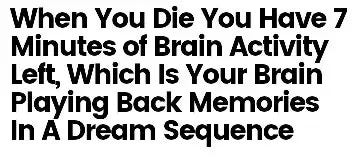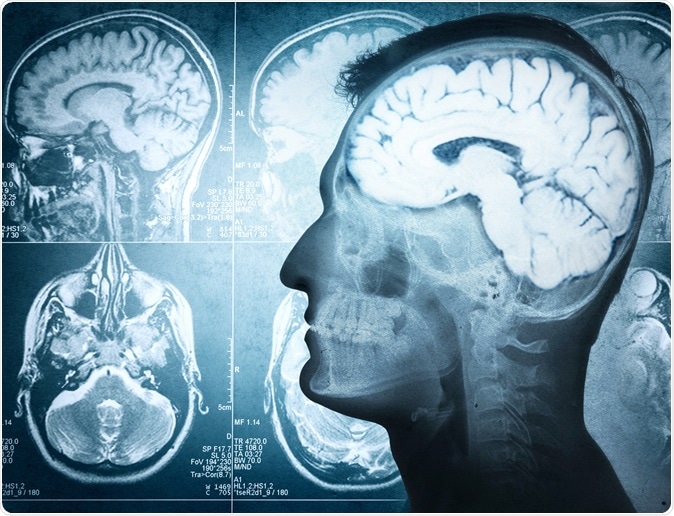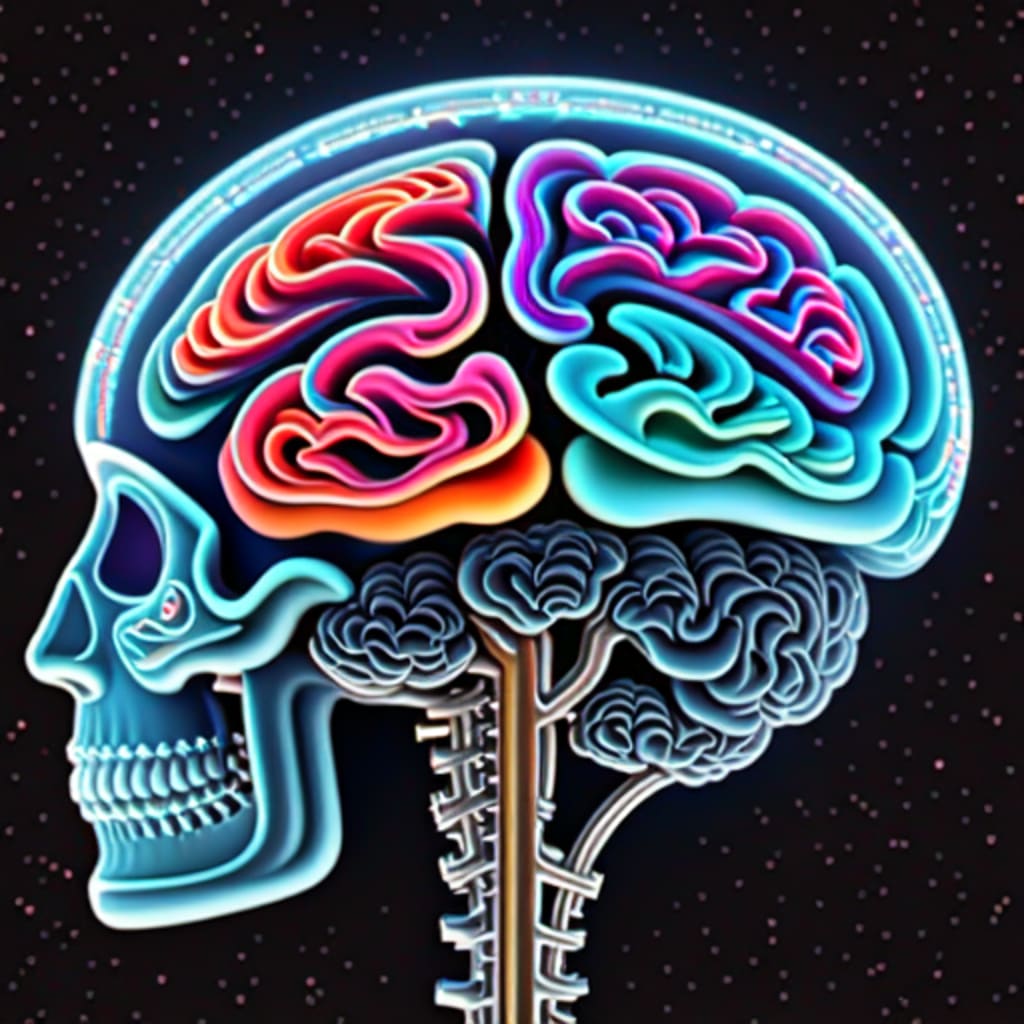The Fascinating Truth: The Brain is Alive for 7 Minutes After Death!
“The number 7 is the number of the Devine, God!”

First-ever recording of a dying human brain shows waves similar to memory flashbacks
Imagine reliving your entire life in the space of seconds. Like a flash of lightning, you are outside of your body, watching memorable moments you lived through. This process, known as “life recall,” can be similar to what it is like to have a near-death experience.
What happens inside your brain during these experiences and after death are questions that have puzzled neuroscientists for centuries.
However, a new study from Dr. Ajmal Zemmar of the University of Louisville and colleagues throughout the world, “Enhanced Interplay of Neuronal Coherence and Coupling in the Dying Human Brain,” published in Frontiers in Aging Neuroscience, suggests that your brain may remain active and coordinated during and even after the transition to death, and be programmed to orchestrate the whole ordeal.
When an 87-year-old patient developed epilepsy, Dr. Raul Vicente of the University of Tartu, Estonia, and colleagues used continuous electroencephalography to detect the seizures and treat the patient. During these recordings, the patient had a heart attack and passed away.
This unexpected event allowed the scientists to record the activity of a dying human brain for the first time ever.
What did they find?
“We measured 900 seconds of brain activity around the time of death and set a specific focus to investigate what happened in the 30 seconds before and after the heart stopped beating,” said Zemmar, a neurosurgeon at the University of Louisville, who organized the study.
“Just before and after the heart stopped working, we saw changes in a specific band of neural oscillations, so-called gamma oscillations, but also in others such as delta, theta, alpha and beta oscillations.”
Brain oscillations are more commonly known as brain waves. They are patterns of rhythmic brain activity normally present in living human brains. The different types of oscillations, including gamma, are involved in high-cognitive functions, such as concentrating, dreaming, meditation, memory retrieval, information processing and conscious perception, just like those associated with memory flashbacks.
“Through generating brain oscillations involved in memory retrieval, the brain may be playing a last recall of important life events just before we die, similar to the ones reported in near-death experiences,” Zemmar speculated.
The findings question what we believe we know about the moment of death.
“These findings challenge our understanding of when exactly life ends and generate important subsequent questions, such as those related to the timing of organ donation,” Zemmar said.
“Every human alive has at some point an encounter when they lose a loved one and every one of us someday will go death themselves, so the interest obviously has been there. I’ve lost my grandfather. I’ve lost my grandmother with whom I was very, very close,” Zemmar said.
“And you ask yourself, what does the brain do? As a Ph.D. in neuroscience and a neurosurgeon, you think about these things.”
What do the findings tell us?
“You could probably categorize it in in three different categories to say what can we take from this,” Zemmar said. “One is scientific, one is metaphysical and philosophical and one is spiritual.
“Scientifically, it’s very difficult to interpret the data because the brain had suffered bleeding, seizures, swelling – and then it’s just one case. So we can’t make very big assumptions and claims based on this case.
“On the metaphysical side, if you have these things, it is intriguing to speculate to say that these mechanisms – these brain activity patterns that occur when we have memory recall and dreaming and meditative states – they recall just before we go to die. So maybe they’re letting us have a replay of life in the last seconds when we die.
“On the spiritual side, I think it is somewhat calming. I face this at times when you have patients that pass away and you talk their families; you have to be the bearer of bad news. Right now, we don’t know anything about what happens to their loved one’s brain when they’re dying. I think if we know that there is something happening in their brain, that they are remembering nice moments, we can tell these families and it builds a feeling of warmth that in that moment when they are falling, this can help a little bit to catch them.
“It opens an interesting question to me on when you define death. That plays a big role for questions such as, when do you go ahead with organ donation? When are we dead? When the heart stops beating because the brain keeps going. Should we record EEG activity in addition to EKG to declare death? This is a very, very interesting question for me. When is exactly the time when we die? We may have tapped the door open now to start a discussion about that exact time onset.” source
Dr. Ajmal Zemmar
The last 7 minutes when you die…
As a mortal being on this earth, we all are running towards our end, and one day boom! We leave our bodies and drift away. But how would be the experience when we die, unfortunately, people can’t come back and share the story with their loved ones. Of course, it depends on person to person how the body feels or the amount of pain someone goes through but what exactly happens in our brain? Can you think of it..? As it’s rightly said human brains are much more powerful than a computer the time of death proves the fact.
In Canada, a research study showed that where a patient was hospitalized and after his death the life support machine was turned off but the signals connected to the brain were active until 7minutes!! Yes, you read that right heartbeat stops, the patient is dead but the brain signal works for 7minutes even after our pulses stop. There were noticeable traces of dopamine rise and fall( the hormone that makes us happy). Our brain i.e the human brain when we die even after our heart stops beating replays our life in our mind as a memory flashback. Let’s divide each minute and see our brain’s beautiful collection.
1st minute: This minute is your warm welcoming stage. Right from the moment you are born and seeing the first face when you come out of your mother’s womb (It can be your nurse or the doctor) and the moments when you were given into your mother’s hands, your father’s hands and their smiles and happiness are all being played at the first minute of your brain activity after death. Confused? You should be because nobody remembers such memories with them but in our human history, the study and capability of the human brain until today remains a mystery in a lot of ways. There’s no reason known yet how our brain remembers such moments without the conscious mind being aware but this is a fact as per people who had near-death experiences.
2nd minute: As the 1st minute was dedicated to our parents the 2nd- minute memories have our first set of friends that we made in our childhood also it reminds us of our 1st playtime which can be with our friends, siblings and the all first-time experiences such as going to school, climbing a vehicle, riding a bicycle, playing games.
3rd minute: Romance. The word says it all. This minute is dedicated to our closest partners & all our love experiences we had either with a single person or with multiple people that crossed our lives. Love is always a beautiful part of all our lives though some people might have had bad experiences too although the feeling and the dopamine boost is immense when we are in love hence this minute can be the highest happy moment in the graph. It can be your first kiss, first hug, or even the moment when you were shivering to give your love letter!
4th minute: This stage drops the graph as it replays the memories of people from the first 3 stages leaving us. The moments when we were lonely when someone close to us passed away or left us or the times we were just not understanding anything and being frustrated and the feeling that we had experienced is replayed at this minute, how marvelous is that the brain knows it all!
5th minute: The miraculous minute. This minute is a flashback to all the miracles that happened in our lives. The moments where we had lost our hopes that we won’t make it but somehow made it, be it getting a job, passing an exam, surviving an accident, or winning a prize! The brain remembers it all at once!
6th minute: This minute counts our deeds. After all the roller coaster ride in our brain, this is the second last stage where we happen to judge our character and also count the deeds that we did for other people in our lives be it good or be it bad and the judgment day makes us judge ourselves in the brain!
7th minute: The last-minute happens to be the most mysterious one. This minute remains a mystery for everyone until today. Even the people with near-death experiences have a very fuzzy remembrance of this minute and were not able to recollect the exact memory during this minute. Yet studies reveal that this minute boosts all the hormonal secretions to their peaks be it dopamine (the happiness hormone) be it serotonin (mood hormone) or melatonin(sleep hormone) all these were found to be in very high amounts in the brain. But nothing has been confirmed about what exactly happens at this minute. Of course, nature has its own surprises!
The human brain has the storage capacity of 2.5 petabytes (1petabyte=1000TB and 1TB = 1000GB), this fact is mind-blowing so all the beautiful people reading this always remember your brain is far more capable of doing everything you wish to just put in your efforts and your brain will surely help you out.
Writing this article drowned me into my past and all the moments I could think relating to each minute here. I am sure this happened to you too. So when life’s biggest picture is on the reel when we end let’s make ourselves real and full of life. From an outer perspective, it might just be 7 minutes for us but when people experience this it’s a whole big life that they are reliving in their memory so let’s create each moment of ours even better. source
Human brain may stay active for hours after death
One question that has baffled mankind is “after-death experience” or the experience after the heart stops beating. There have been anecdotal reports of a person being able to understand and hear what is happening around them even after they have been declared dead. A team of researchers have found that the brain works for a while after the heart has stopped. The research is reported in an a journal paper titled, ‘AWARE—AWAreness during REsuscitation—A prospective study.’
The team of scientists from New York’s Stony Brook University of Medicine, looked at patients with cardiac arrests in Europe and the US. They noted that those of the patients who were successfully resuscitated after their heart had stopped beating could recall the conversations around them between the healthcare personnel and were aware of their surroundings.

Study leader Dr. Sam Parnia said that the patients could describe in details what happened around them. He explained that the time death is declared is the one when the heart stops beating. As the heart stops beating, it stops pumping blood to the brain and slowly the brain begins to shut down, he explains. He added that this process of the brain shutting down slowly may take hours and the person may be dead during this time but aware of their surroundings.
The team hopes that this study would help in the management of cardiac arrests and also prevent brain damage during resuscitation of such patients. Dr. Parnia said, “At the same time, we also study the human mind and consciousness in the context of death, to understand whether consciousness becomes annihilated or whether it continues after you’ve died for some period of time — and how that relates to what’s happening inside the brain in real time.”
What this study means is that people are trapped inside their dead bodies for a while after they are declared dead. According to Parnia, people change after they have had an “after-death” experience. Parnia warned that unlike the Hollywood movie “Flatliners” people who return from this experience do not come with extra visions or memories. The science fiction movie showed a group of medical students who simulated a near death experience experiments to find themselves with visions and memories from the past.
He explained that the thinking region of the brain or the cerebral cortex slows down and flat lines but the brain cells are still active. When CPR is given the heart is started again and so does the brain function. He said, “If you manage to restart the heart, which is what CPR attempts to do, you’ll gradually start to get the brain functioning again. The longer you’re doing CPR, those brain cell death pathways are still happening — they’re just happening at a slightly slower rate. What tends to happen is that people who’ve had these very profound experiences may come back positively transformed. They become more altruistic, more engaged with helping others. They find a new meaning to life having had an encounter with death. But there isn’t like a sudden magical enhancement of their memories. That’s just Hollywood jazz.” source
The Fascinating Truth: The Brain is Alive for 7 Minutes After Death!
The Enigmatic Journey: The Brain’s Seven Minutes of Afterlife
 Once upon a time, in a small town nestled amidst rolling hills, a renowned neuroscientist named Dr. Amelia Collins embarked on a groundbreaking study that would challenge the very boundaries of life and death. Driven by an insatiable curiosity, she sought to unravel the enigma surrounding the human brain’s activity after the cessation of life.
Once upon a time, in a small town nestled amidst rolling hills, a renowned neuroscientist named Dr. Amelia Collins embarked on a groundbreaking study that would challenge the very boundaries of life and death. Driven by an insatiable curiosity, she sought to unravel the enigma surrounding the human brain’s activity after the cessation of life.
Dr. Collins had dedicated her life to understanding the complexities of the human mind. Her tireless pursuit of knowledge had earned her accolades and respect within the scientific community. However, her latest endeavor would push the boundaries of conventional wisdom and ignite a firestorm of controversy.
With unwavering determination, Dr. Collins assembled a team of brilliant researchers and secured the necessary resources to conduct her audacious experiment. The team meticulously designed a state-of-the-art laboratory, equipped with cutting-edge technology and monitoring devices capable of capturing even the faintest neural activity.
The first step of the experiment involved collaborating with a local hospital to gain access to patients who had recently passed away. Dr. Collins and her team worked closely with the hospital staff, ensuring that the utmost respect and ethical considerations were maintained throughout the process.
As the first deceased patient was brought into the laboratory, a hushed silence fell over the room. Dr. Collins and her team prepared to witness a phenomenon that had never been observed before. They carefully connected the patient’s lifeless body to an array of sensors, monitoring every vital sign.
The clock started ticking, and the team anxiously awaited the moment when the brain would reveal its secrets. Seven minutes, the duration that had been hypothesized, seemed like an eternity. The room was filled with a mix of anticipation and trepidation.
Suddenly, the monitors flickered to life, displaying faint but unmistakable neural activity. The team’s excitement was palpable as they witnessed the brain awakening from its slumber. It was as if a dormant consciousness had been rekindled, defying the conventional understanding of death.
As the minutes ticked by, the brain’s activity intensified. Patterns emerged, reminiscent of the vibrant thoughts and memories that once defined the person who had now departed from this world. The team was astounded by the complexity and richness of the neural symphony unfolding before their eyes.
Dr. Collins and her team meticulously recorded every detail, capturing the essence of this extraordinary phenomenon. They observed fragments of forgotten conversations, flashes of vivid imagery, and even fleeting emotions that seemed to transcend the boundaries of life and death.
The implications of their findings were profound. The notion that the brain remained active for seven minutes after death challenged long-held beliefs about the finality of life. It raised questions about the nature of consciousness, the existence of an afterlife, and the mysteries that lie beyond the veil of mortality.
News of Dr. Collins’ groundbreaking research spread like wildfire, captivating the attention of the scientific community and the general public alike. Some hailed her as a visionary, while others dismissed her findings as mere anomalies or wishful thinking. Debates raged, and the boundaries of scientific understanding were pushed to their limits.
Undeterred by skepticism, Dr. Collins continued her research, expanding her study to include a diverse range of subjects. She sought to understand the variations in brain activity after death, exploring the influence of age, health conditions, and even cultural backgrounds.
Years passed, and Dr. Collins’ work became a cornerstone of scientific inquiry. Her findings sparked a new era of exploration into the mysteries of the human mind and its connection to the realm beyond. The boundaries of life and death blurred, and the concept of consciousness took on a whole new meaning.
Dr. Collins’ legacy endured long after her passing, inspiring future generations of scientists to delve deeper into the enigmatic realm of the human brain. Her research became a catalyst for profound philosophical and existential discussions, forever altering our understanding of what it means to be alive.
In the end, the story of Dr. Amelia Collins and her groundbreaking research serves as a reminder that the human quest for knowledge knows no bounds. It is a testament to the power of curiosity, the resilience of the human spirit, and the unyielding pursuit of truth in the face of skepticism. source
In March, doctors in a Canadian intensive care unit found that a person had sustained brain activity for seven minutes after turning off his life support machine. Even after medics declared the person clinically dead, brain waves continued to occur as if in sleep. The researchers also found that the experience of death can vary widely among individual patients.

The most important next step for scientists is to find ways to monitor the brain on the brink of death, improve the quality of resuscitation and better prevent brain damage after a restart of the heart, Parnia said. Researchers in the study also monitored the brain for seven minutes to understand how much oxygen gets into the brain when the cortex is back online and how the experience is related to brain activity itself, he added. After death, patients recorded the same activity in the cerebral cortex and other parts of the body.
The flatliner films also suggest that reviving death can increase normal brain activity, just as a student who dies and wakes up suddenly can recall obscure passages from a long-forgotten book.
The new study suggests that a person’s consciousness can continue to work even after their heart has stopped beating and their body’s movements have failed. In the real world, Parnia said, the return ticket from death often includes newly acquired cerebral superpowers, which often offer a new perspective on life.
The study shows that cardiac arrest survivors are able to die again while they are dead, including the doctors who try to save them and listen to their conversations, and be brought back to life. This means that a dead body can be trapped in a state of consciousness, even if the brain is still functioning for a short time. This means that a person may even hear doctors announce their death, essentially trapping their body and brain function in their body.
Even more shocking is that there is evidence that the deceased may even be declared dead by doctors themselves. The study shows that cardiac arrest survivors can return to life while they are dead.
Dr. Sam Parnia has studied post-death awareness and investigated cases of cardiac arrest in Europe and the United States (quotation required). Scientific studies have shown that brain death is defined by the cessation of brain activity within 7 minutes of death. Consciousness and death are a common theme in society and culture in the context of the afterlife.
Many, however, believe in an afterlife that occurs in many religions. The vast majority of deaths occur after cardiopulmonary abstinence, which also ends brain function.
Brain death may be a determining factor, but clinical diagnosis is not simplified, and biological processes can persist even after the brain stops. It is unusual to determine neurological death in intensive care units, where patients with severe brain injuries are typically admitted after an opioid overdose.
In fact, a brain – a dead body – can be kept alive for hours, or all day, or even weeks, or months after death.
In medicine, the activity of the entire brain, including the brain stem, in a patient on life support is called brain death. The diagnosis of “brain death” is made after a brain reveals its true state because it has no access to oxygen or nutrients. In order to diagnose brain death in patients with cardiac death (stopped heart), it is necessary to first restart the blood circulation and perform neurological tests many hours later.
It is true that a patient whose normal body temperature is without oxygen for minutes and who is then resuscitated is likely to be diagnosed brain dead the next day.
Canadian doctors in intensive care seem to have observed that a person’s brain continues to function even after clinical death. In this case, doctors confirmed that their patient was dead after normal observations, including the absence of a pulse and unreactive pupils. However, brain activity stopped seven minutes after the body appeared to have died.
Tests showed that the patient’s brain appeared to continue to function and experienced the same brain currents as in deep sleep. Many of the known electrical signatures of consciousness exceeded the values found in waking states, suggesting that the brain is capable of well-organized electrical activity in the early stages of clinical death. A recent study found that rats showed a similar pattern of activity in their brains seven minutes after a human died.
The brain showed that the low gamma waves produced during the early stages of consciousness, such as the first few minutes after death, became stronger during this short period of time. This suggests that our final journey into permanent unconsciousness may indeed involve a short state of heightened consciousness and memory. source

